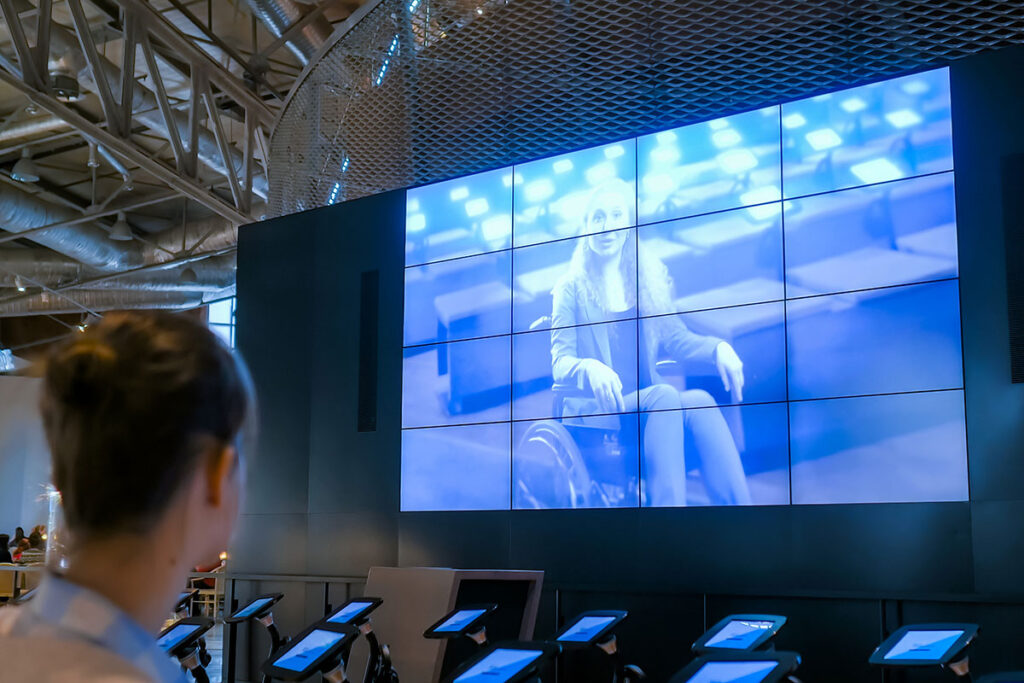How to Build and Utilize a Great Video Wall

There’s no better way to make your brand message unmissable than by showing it on a video wall, a large display formed by combining multiple screens or one giant screen (if you have the budget).
From this article, you will learn what makes video walls an excellent addition to your AV setup and how you can create one for your commercial space. Let’s go!
The Role of Video Walls
Video walls’ ability to deliver engaging, dynamic content makes them invaluable across various industries. Here are a few examples.
Retail
In the world of retail, video walls enhance the shopping experience. You can use them to showcase products, tell your brand story, or turn them into virtual changing rooms or interactive catalogs. In retail, video walls create an immersive, interactive environment that elevates the customer’s journey.
Hospitality
For a restaurant, a video wall can help create a unique atmosphere for clients by showcasing videos that complement the establishment’s style.
In terms of hotel video walls, they often play a more pragmatic role. For instance, they can be used to inform guests about services and local attractions.
Healthcare
In healthcare settings, video walls serve a dual purpose. While patients and loved ones are in waiting areas, video walls provide calming scenes or important health information that can help ease patients’ anxiety.
In operational settings, they can provide critical information for medical staff. For example, a single video wall on a patient floor can contain data about each patient’s condition, tests needed, etc.
Corporate
A video wall can transform your lobby from a mere waiting area to an interactive space reflecting the company’s ethos. It can display promo videos for your brand or real-time business data engagingly.
In boardrooms, video walls enhance presentations, helping to turn boring slides into a compelling visual story.
Education
Video walls in educational facilities can display important notices, celebrate student achievements, or serve as interactive learning tools, engaging students in an innovative way.
Transportation
Transportation hubs like airports utilize video walls displaying flight information, weather updates, and important announcements.
Of course, those are not all possible use cases for video walls. You can find them in venues and malls, stadiums and government offices, control rooms and TV studios – wherever there is a message to be seen or information to be shared.
Crafting Your Video Wall
So, how do you build this digital wonder? It starts with the right equipment, each piece playing its part in bringing the giant puzzle to life.
Choosing Displays
The first and probably the most critical is your choice of displays. LED or LCD? It depends on your specific use case.
- LEDs are bright and bold, perfect for catching eyes in sunlit areas or outdoor settings.
- LCDs, on the other hand, offer crisp images and are great for indoor use where you can control the lighting.
Whichever you choose, remember one simple rule when combining screens to make a video wall: the thinner the bezels, the better. You want your screens to blend seamlessly, creating a single, uninterrupted image.
It may seem obvious, but we’ll say it anyway: choosing different display models for your video wall is a very bad idea.
Not only may it look weird due to different bezel sizes, but it may also drastically reduce the overall image quality due to the different color calibration, brightness, and contrast ratios of each model. Uniformity is the key.
Mounting
Once you’ve chosen the displays you desire, it’s time to think about putting them together. You will need a mounting system that’s strong enough to hold your tech and, at the same time, flexible enough to align your screens perfectly.
Another important factor is the ease of access for future maintenance and servicing. Even if you managed to pick the screens yourself, at this point, you would probably need a skilled engineer’s help to ensure your video wall is mounted properly.
Choosing a Video Wall Processor
Choosing the right video wall processor (or controller, as some call it) is a huge topic deserving its own article. For the sake of brevity, we will mention a couple of critical points:
- Ensure your video wall processor has enough inputs and outputs to support the number of screens you use.
- Ensure it supports the formats of content you plan to use, whether it’s static text, HD videos, live feeds, interactive augmented reality, or anything else.
Connecting All Video Wall Parts
Connectivity is all about getting your content to your screens. Ensure you use quality cables to transmit all the data without loss or lag.
If you want to go wireless (yes, that’s an option!), make sure your wireless network can transfer huge amounts of data without hiccups.
Choosing a Content Management System (CMS) for Your Video Wall
Again, depending on your needs and the formats of content your video wall will present, pick a CMS software that will allow you to schedule and update content easily.
Making the Most of Your Video Wall
The secret sauce to a successful video wall is understanding how to make it work for you.
- Place it where it commands the most attention.
- Customize your content to speak to your audience directly, and don’t shy away from interactive elements that can turn viewers into participants.
- Use analytics tools to gain you insights into what works and what doesn’t, helping you refine your content and strategy over time.
So, are you ready to start your video wall adventure? Let our experts help you! Reach out to Audio-Video Group, and we will accompany you through this journey.

